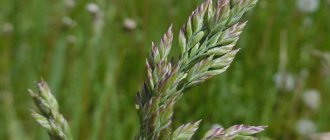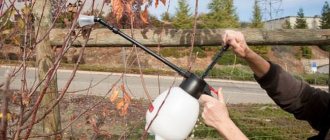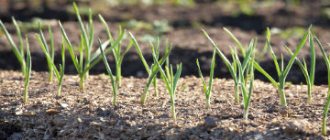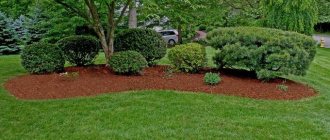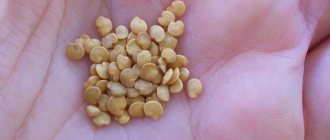When is it better to plant: autumn or spring? comparison table
You can plant lawn grass in autumn or spring. Some varieties are suitable for sowing in summer.
| Advantages | Flaws | |
| Spring |
|
|
| Autumn |
| Possible frosts |
Spring is considered a more suitable time for sowing grass, since in the natural environment it is at this time that greenery begins to grow.
April is best for planting, since at this time the ground has a sufficient supply of moisture after winter snow. If you start planting in May, you should ensure regular and intensive watering. March is a dangerous month, as in some regions there may be severe frosts at this time, which will destroy the first shoots.
Planting a lawn before winter
A large number of gardeners begin planting a lawn after the soil has slightly frozen. This method of sowing is called “wintering”. It differs from autumn planting in that sowing is done in November. Seeds are planted before snow cover forms.
Important! When planting, the ambient temperature must be above zero, otherwise the sprouts will die. Seeds must be mulched.
A significant advantage of winter sowing is the active growth of lawn grass in the spring. “Pre-winter” sowing allows you to grow a lawn the next year. This planting method is not suitable for sloped areas due to spring melt, which can wash away the seeds.
The choice of sowing time depends on the specific situation. It should be done by weighing all the advantages and disadvantages of each method. The right choice will allow you to grow green grass for your garden.
Sowing dates by region
For sowing, you need to choose a time when the snow has already melted, but the soil remains well moistened. Depending on the region, sowing dates may vary.
| Region name | Deadlines |
| Southern regions of Russia | Beginning or end of March |
| Middle lane | Beginning or end of April |
| Ural and Siberia | End of April - beginning of May |
| Northwestern region | Beginning of May |
Some gardeners rely on lunar calendar dates when planting with their own hands. On these days, the chance of getting a beautiful green lawn is slightly higher than on others. The best dates according to the lunar calendar 2021:
- March 15th;
- 11 April;
- May 8, 17.
What type of grass is best to use?
You can immediately choose ready-made herbal mixtures at a garden store. Among these mixtures are:
- sports - suitable for landing on a football field;
- universal - suitable for any lawn, but require frequent mowing;
- frost-resistant - used for planting in cold regions;
- elite - require certain conditions of maintenance, but look very stylish;
- meadow - these varieties will turn the lawn into a small meadow with various splashes of flowers.
For the Russian climate, you can choose not mixtures, but individual herbs that will look great on your house or summer cottage.
Bluegrass
Bluegrass is a perennial herb that is used as a base for grass mixtures. The grass is easy to care for and has good germination.
Polevitsa
This type of grass grows thickly and leaves no empty spaces on the lawn. Bentgrass has a rich green color and is resistant to frost and frequent cutting.
Ryegrass
This herb goes well with cereals. Despite the fact that ryegrass can be used to create an excellent decorative lawn, it does not tolerate frost well, so it is mainly used in the southern regions. The variety does not require pruning and is often found in elite grass mixtures.
How to choose seeds for sowing a lawn
A lawn is a dense, stable covering of grass. To create such a covering, lawn grasses and grass mixtures are used, that is, special crops that are bred through long-term selection. For this reason, lawn grasses are very different from their wild relatives: the lawn is softer, more delicate, decorative, it creates a uniform, dense covering (thanks to thinner and smaller leaves).
The main plants for creating a lawn: bluegrass, fescue, ryegrass, timothy grass, bentgrass, white clover.
Planting begins with choosing a lawn mixture (that is, seeds of certain grasses and grains in a certain proportion). There are different types of lawns that differ in their characteristics and functions. Therefore, before choosing a seed mixture, you need to decide what exactly you need.
All lawn grasses are perennial plants that bush densely and form a dense turf.
Lawns are divided into several types (depending on function):
- Sports turf. Designed for heavy loads (walking, sports games). The grass must be resistant to trampling and any other mechanical influences, and at the same time not lose its decorative effect. For these purposes I use a lawn mixture of red fescue and meadow grass.
- Parterre lawn. Performs a purely decorative function and is not suitable for walking or any other mechanical impacts. In addition, it needs more meticulous care. It is planted to decorate the most ceremonial areas in the garden, at the dacha. The following mixtures of herbs are used: perennial ryegrass, meadow bluegrass, victorious bentgrass and others.
- Landscape lawn (ordinary) . It plays a decorative role in the garden, while it is able to withstand moderate loads (that is, you can walk on it), and it can withstand adverse weather conditions.
- Meadow lawn. It differs in that it grows grasses with hard stems. Resembles natural grass cover. This variety must be resistant to stress so that gardeners and summer residents can spend time on the meadow lawn: sunbathing, relaxing (however, it is not suitable for active recreation). Suitable herbs: clover, bluegrass, timothy grass and others.
- Moorish lawn. The most colorful and picturesque variety, because it includes not only herbs (bluegrass, bentgrass and others), but also flowers (cornflowers, poppies, eschscholzia, flax, nemesia, calendula, cosmos, etc.). Visually similar to a blooming meadow. This variety is not only beautiful, but also useful - it attracts bees to the garden.
There is also a rolled lawn - a thin layer of turf that is rolled into a tight roll. When purchasing such rolls, the gardener does not need to think about sowing seeds; the rolls are sufficiently grown in the selected areas.
Therefore, before purchasing a lawn seed mixture, you must decide what type of lawn you need. And based on a specific goal, choose the appropriate mixture in a garden center or country-themed store. You also need to select herbs depending on the place in the garden and the type of soil.
Seeding tools and step-by-step instructions
To get a perfect lawn, you need to be patient and have the right tools.
Planting Tools:
- rake;
- shovel;
- manual roller;
- root extractor;
- pitchfork;
- watering can.
Before planting, it is necessary to prepare the area for planting grass.
Soil preparation
The ground must be leveled and excess bumps or holes removed. To do this, use a shovel and a rake. The soil should be loosened so that air can pass to the roots of the plants.
Use a soil mixture that meets the following requirements as soil:
- pH: 5.5–6.5;
- humus: from 2.5 to 3.5%;
- nitrogen and its compounds: 10 mg per 100 g of soil;
- phosphorus: 15–25 mg per 100 g of soil;
- potassium: 20–30 mg per 100 g of soil;
- microelements: control of copper and zinc content.
Sand must be added to the soil to make it looser.
Tamping
To keep the lawn level, you need to compact the soil. The procedure is performed using a garden roller. If there is no such device, then the soil can be slightly moistened and trampled with your feet. Shoe marks can be removed with a rake.
If voids are formed during compaction, they should be filled with new soil.
Pre-sowing preparation
Before planting seeds, it is important to carry out the following activities:
- A week in advance, scatter mineral fertilizer throughout the prepared soil.
- Loosen the soil so that minerals penetrate deep into the soil.
- A day before, walk the rake over the ground again so that no large lumps remain.
After this, you can start sowing grass.
Step-by-step instructions for sowing lawn grass
If a mixture of grasses is used, the seeds must be mixed well before planting to ensure a beautiful lawn.
- Divide the total number of seeds into 4 parts.
- Sow 1 part of seed per 1/4 of the lawn.
- Sow seeds in different directions (along and across the grooves that remain after loosening).
- Walk across the lawn with a fan rake without stepping on the ground.
If the soil is wet, then watering is not required; if it is dry, then the seeds should be carefully watered using a watering can or drip irrigation system.
Features of sowing lawn grass
Spring
Pros:
- Any lawn grass develops quite intensively. Having planted it in the spring, the summer resident will receive a full-fledged “green carpet” on the site already in the same season.
- It becomes possible to “adjust” the lawn, promptly identify and eliminate mistakes made during its formation. All shortcomings (for example, uneven planting of seeds) will immediately be visually noticeable as soon as the first shoots hatch.
Minuses:
- With the onset of the season, there is already enough work on the acres - plowing the land, whitewashing trees, fighting weeds and pests that have survived the winter. The list can be continued indefinitely, if you consider that it is in the spring that we often have to repair the perimeter fence, replace burst pipes, paint the peeling facade of the house, install a frame pool, swings and much more. Will a summer resident have time to plant lawn grass, given that this work is quite extensive?
- The soil on which the “green carpet” is supposed to be grown will have to be prepared in advance. Even earlier than for garden crops. It is advisable to keep the land fallow for 2 to 4 weeks, depending on local specifics. This means that agricultural work will have to be carried out in not the most favorable conditions - it is cold, the earth is not warmed up enough and is difficult to cultivate. And the roads are not yet dry everywhere, so getting to the site is often a big problem, especially since country buses have not yet started their routes.
- The difficulty of caring for lawn grass in the spring. Regular irrigation, fertilization, combating the dominance of weeds (and with the end of the cold weather they develop very rapidly), pests, cutting - all this requires time and effort.
In order for the lawn to form faster in the spring, it is necessary to feed the grass root system with preparations with a high nitrogen content. It promotes the active development of green mass.
Autumn
Pros:
- You don’t have to waste time on large-scale preparation of a plot of land for lawn grass. Any summer resident knows how much work has to be done in the spring before starting to plant annual garden crops. In this regard, autumn is preferable. After harvesting, there is time to take care of the lawns, especially since during the summer period the main agrotechnical measures have been carried out (ploughing, fertilizing, etc.), therefore, the territory is sufficiently landscaped and well-groomed. This means that it is almost completely prepared for the installation of the “green carpet”.
- The saturation of the soil and air with moisture is optimal, and summer heat is no longer expected, and the temperature is most favorable for vegetation. From this point of view, it is, of course, better to plant lawn grass in the fall.
- During this period, the growth of weeds slows down significantly and then completely stops. This means that it consumes less and less nutrients from the soil. This favors a more intensive formation of the root system and promotes the development of its shoots (if it is planted at the very beginning of autumn).
- As soon as favorable weather sets in in the spring, the summer resident constantly experiences a lack of time. There is so much that needs to be done in a relatively short period that there are literally not enough hands to do it all. And if lawn grass is planted in the fall, then after the snow melts it will not require any care - it will immediately please the owners of the site with a wonderful “green carpet”.
- Grass planted in late autumn develops quite rapidly with the onset of spring. Consequently, weeds will not be able to “strangle” its strong shoots.
Minuses:
- Difficulty in choosing a grass mixture. It is necessary to select seeds only from those plants that will safely survive the winter, and in this particular region. Read more about choosing the type of lawn grass here.
- If the amount of precipitation in winter is small, you will have to think about artificially insulating the soil in the area where the lawn is laid out. Naturally, take appropriate measures. For example, cover it with peat and lay spruce branches on top. All this requires time, which is usually not enough in the fall.
- One of the disadvantages of planting lawn grass before winter is that the end result is extremely difficult to change. After the spring emergence of the sprouts, all that remains is to state what happened and how. That is, “what has grown has grown.” The issue of adjusting the lawn is quite specific; it requires a professional approach, and sometimes, if there are significant shortcomings, all the work done in the fall has to be redone almost from scratch. Those who are arranging a “green carpet” for the first time need to prepare especially carefully, and first of all, be savvy in terms of theory.
- Limitations due to terrain. If the site has a slope, then planting grass in the fall is pointless. In spring, melt water will easily wash out of the soil and carry away most of the seeds.
Care after landing
The first shoots will appear in 7-10 days. At this time, you need to monitor the soil moisture and, if necessary, water the lawn every 2-3 days. If it rains, no watering is needed.
In spring, the lawn needs the following care:
- cleaning up debris;
- combing with a fan rake;
- treatment for fungi if necessary;
- reseeding areas that were left bare (the grass might not sprout).
The first lawn mowing is carried out when the grass reaches 8-10 cm.
With proper care, the lawn will be beautiful and green throughout the entire summer season. Regular weeding will help get rid of weeds. If the grass turns yellow due to drought, you should install a drip, automatic irrigation system.
Preparing to plant a lawn
Growing an even lawn is not a mission impossible, but it will require care and time.
The lawn requires periodic maintenance, moistening, removing weeds, and applying fertilizers. It is sown in spring or autumn. Planting can also be done in the summer, if there are favorable climatic conditions conducive to seed germination.
Preparing the soil for sowing a lawn
Before planting, the area must be prepared.
To do this, on the site of the future lawn:
- remove garbage;
- get rid of plant residues;
- uproot trees or bushes.
The area to be prepared must be dug to the depth of a spade bayonet. At the same time, chemical disinfection against pests is carried out. If the place has been neglected for a long time, then the chemical treatment should be repeated twice.
Excessively wet soil requires drainage measures. Remove the top layer of soil with a shovel. The earth is compacted and a layer of pebbles 20 cm thick is laid out. It is covered with coarse sand 10 cm deep on top. The drainage layers must be leveled, creating a slope towards the ditches to drain water. Then the soil is laid in place.
